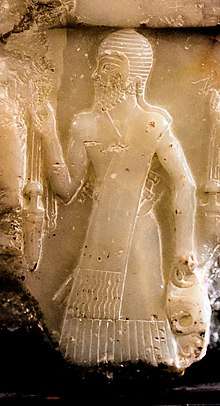Armani (kingdom)
Armani, (also given as Armanum) was an ancient kingdom mentioned by Sargon of Akkad and his grandson Naram-Sin of Akkad as stretching from Ibla (which might or might not be Ebla) to Bit-Nanib; its location is heavily debated, and it continued to be mentioned in later Assyrian inscriptions.

Location
Syria: Armani was mentioned alongside Ibla in the geographical treaties of Sargon. This led some historians to identify Ibla with Syrian Ebla and Armani with Syrian Armi.[2]
Mesopotamia: Michael C. Astour refused to identify Armani with Armi, as Naram-Sin makes it clear that the Ibla he sacked (in c. 2240 BC) was a border town of the land of Armani, while the Armi in the Eblaite tablets is a vassal to Ebla. Armani was attested in the treaties of Sargon in a section that mentions regions located in Assyria and Babylonia or territories adjacent to the east, in contrast to the Syrian Ebla, located in the west. The later King Adad-Nirari I of Assyria also mentions Armani as being located east of the Tigris and on the border between Assyria and Babylon.[3] Historians who disagree with the identification of Akkadian Armani with Syrian Armi place it (along with Akkadian Ibla) north of the Hamrin Mountains in northern Iraq.[4]
The site of Tall Bazi has also been suggested as the location of Armanum. [5][6]
History
—Naram-Sin describing his capture of the king of Armani.[7]
First mentioned as the land of Armani by Sargon, Naram-Sin boasted about his victory and destruction of the city. He gives a detailed account of the siege and the capture of Armani's king in one of his inscriptions.
Armani was later mentioned amongst the cities that rebelled against Naram-Sin.[2] During the Middle Assyrian and Kassite periods, the land of Armani was mentioned as located east of the Tigris. King Shalmaneser III mentions his conquest of Halman, but the identification of Halman with Akkadian Armani (Arman) is dubious according to J.A. Brinkmann.[3]
Theorized connection with the name of Armenia
It was suggested by early 20th century Armenologists that Armani is the earliest form of the name Armenia.[8]
References
Citations
- McKeon, John F. X. (1970). "An Akkadian Victory Stele". Boston Museum Bulletin. 68 (354): 239. ISSN 0006-7997. JSTOR 4171539.
- Wayne Horowitz (January 1998). Mesopotamian Cosmic Geography. p. 82. ISBN 9780931464997.
- Brinkmann J.A. Political history of Post-Kassite Babylonia (1158-722 b. C.) (A). p. 195.
- Cyrus Herzl Gordon; Gary Rendsburg; Nathan H. Winter (January 1987). Eblaitica: Essays on the Ebla Archives and Eblaite Language, Volume 4. p. 63,64,65,66. ISBN 9781575060606.
- Adelheid Otto, Archeological Perspectives on the Localization of Naram-Sin's Armanum, Journal of Cuneiform Studies, vol. 58, pp. 1-26, 2006
- Berthold Einwag, Adelheid Otto: Tall Bazi 1998 und 1999 – Die letzten Untersuchungen in der Weststadt. Mit einem Beitrag von Jörg W. E. Faßbinder und Helmut Becker. In: Damaszener Mitteilungen. Band 13, pp. 65–88, 2002
- William J. Hamblin (27 September 2006). Warfare in the Ancient Near East to 1600 BC. p. 220. ISBN 9781134520626.
- Ibp Inc (September 2013). Armenia Country Study Guide Volume 1 Strategic Information and Developments. p. 42. ISBN 9781438773827.